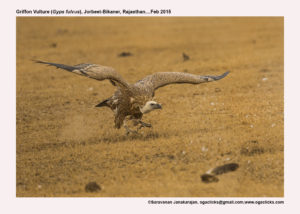Griffon Vulture

Griffon Vulture Gyps fulvus
Etymology:
- Gyps : Greek word gups – vulture.
- Fulvus : Latin word fulvus- tawny
Vernacular Names: Pun: Bhurigidh, Guj: Badamigidh, Pahadigidh, Mar: Eurasian Gidhad
Distribution in India:Resident in North and Central India.
Description: Size of 93–110 cm; wt. of 6000–10,000 g; wingspan of 234–270 cm. It is a huge vulture with whitish head, neck and collar. It has yellowish bill with black cere, buffy –rufescent upperparts, and rufous- brown underparts, thighs with prominent pale streaking and dark grey legs and feet. Rufous -brown underwing coverts show prominent whitish banding. It has dark centers to greater upperwing-coverts. The immature is richer rufous brown on upperparts and upperwing-coverts, rufous-brown feathered neck ruff, more whitish down that covers the grey head and neck, blackish bill and dark iris. Thejuvenile has brown collar and darker back than adult.
Habitat: It is found in mountains, plateaux, steppe and even semi desert, with abrupt rocky areas such as crags and canyons for nesting and roosting. It breeds at wide range of altitudes, from cliffs at sea level up to 2750 m.
Food habits: It feeds on, carrion. It feeds mainly on muscles and viscera of medium sized and large mammals, especially ungulates. Sometimes eats other mammals like rabbits and hares.
Breeding habits: They breed in Dec–Mar. It nests on crag or cliff, preferring protected ledge or small cave. The nest is thin, fairly small platform of branches, sometimes stolen from other large raptors. They lay a clutch of single egg. The incubation period is 50–58 days. Both adults incubate the egg, and feed chick by regurgitating semi digested food.The fledging period is 110–130 days. The chicks receive food from parents for three months more.